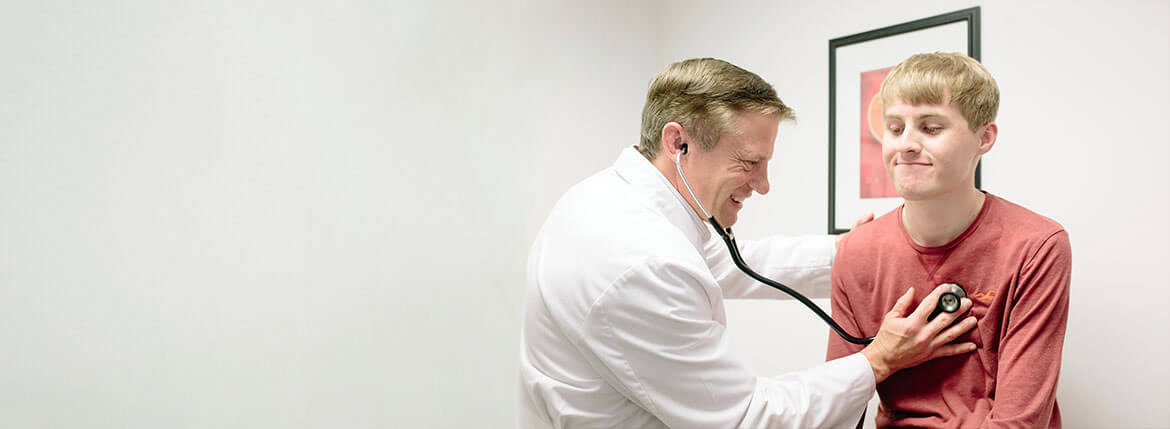At this time, the recommendation of the physicians at Pediatric Heart Specialists is that all children, including those with congenital heart disease, receive the COVID 19 vaccination, if eligible by age.
What are palpitations?
Palpitations refers to a sensation that the heart is beating irregularly, faster, or harder than normal. Palpitations in children are relatively common. In many instances palpitations can be completely normal! However, it is important to thoroughly evaluate a child who is having palpitations to rule out the possibility of any type of more serious cause.
Every time the heart squeezes it requires an electrical impulse. The impulse originates from an area in the top right corner of the heart known as the sinus node. Electricity then spreads across the upper two chambers of the heart. It travels to the lower two chambers through a specialized conducting pathway known as the AV node. Normally the only way for electricity to travel from the upper to the lower chambers is through the AV node. In children a normal heart rate can vary tremendously. When asleep, a child's heart rate may be as low as 30-40 beats per minute. When exercising, a child's heart rate may increase as high as 200 beats per minute. Most changes in the heart rate are mediated by the body’s natural adrenaline. Increases in adrenaline cause the heart to squeeze faster and more forcefully than normal. Increases in adrenaline can be seen in a number of situations: exercise, emotion such as fear or pain, anxiety or stress, and during physical illness.
Causes of palpitations
In general, palpitations can be caused by one of three different mechanisms. The most common scenario is in a child who is in a “high adrenaline” state. For example, a child who is anxious or experiencing an emotion such as fear will be in a “high adrenaline” state. In this setting, the adrenaline produces a faster and stronger heartbeat than normal. The child may then interpret the faster and stronger heartbeat caused by the adrenaline as a primary heart symptom, when in reality the heart is responding perfectly appropriately to the body's signals. A recording of the heart rhythm in this circumstance will show a normal appearing rhythm that may or may not be slightly faster than expected (termed sinus tachycardia). Many children with palpitations due to a high adrenaline state experience other symptoms such as chest pain, shortness of breath, dizziness, sweatiness, or fatigue. Usually these additional symptoms are caused by adrenaline as well. It is important to emphasize that in this setting there is no true heart problem to be treated.
A second cause of palpitations is isolated “extra” heart beats, termed premature contractions. A premature contraction may come from either the atria or the ventricle. Premature contractions from the atria are termed premature atrial contractions, or PAC's, while those from the ventricle are termed premature ventricular contractions, or PVC's. In most otherwise healthy children and teenagers, PAC's and PVC's are usually benign. They are typically due to a slightly overactive piece of electrical tissue that every so often generates its own electrical impulse in addition to the normal sinus node. Almost everyone has occasional PAC's and PVC's. Most children don't feel them; however, some do. Generally, isolated PAC's and PVC's do not require any special treatment.
A final cause of palpitations is termed supraventricular tachycardia (SVT). SVT is a true electrical disorder of the heart which involves an abnormal electrical circuit between the top and bottom chambers. Children with SVT usually experience the sudden onset of a very rapid heart rate. They may experience a sensation of dizziness as well. In most cases, SVT requires treatment with either medication or a procedure to completely eliminate it.
Diagnosis of palpitations
Making a diagnosis in a child with palpitations is usually straightforward. Most of the time it involves using a monitor of some type to record the heart rhythm when the child is having symptoms. If the child is having symptoms daily, a 24-hour monitor may be used. Otherwise, an event monitor may be used during the course of a month to make recordings of the heart rhythm when experiencing symptoms. SVT is usually very obvious based on the appearance and rate of the heart rhythm. PAC's and PVC's are likewise easy to diagnose based on the appearance of the recording. Recordings from children with palpitations due to excess adrenaline often look like completely normal recordings, or may show a slightly accelerated but normal heart rhythm (sinus tachycardia).
Treatment of palpitations
Treatment of palpitations depends on the underlying cause. Palpitations caused by supraventricular tachycardia may require medication or a procedure to cure the problem. Palpitations caused by premature beats usually require no treatment at all. Likewise, palpitations caused by sinus tachycardia also do not require treatment in most instances. Rarely a medication such as a beta blocker may be used to relieve the child of the sensation of palpitations if it is extremely distracting to them.

